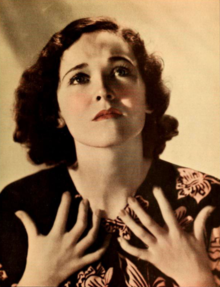Maureen O’Sullivan
| Maureen O'Sullivan | |
|---|---|

O'Sullivan in Photoplay, 1932
|
|
| Born |
Maureen Paula O'Sullivan 17 May 1911 Boyle, County Roscommon, Ireland |
| Died | 23 June 1998 (aged 87) Scottsdale, Arizona, U.S. |
| Occupation | Actress, Singer |
| Years active | 1930–94 |
| Spouse(s) |
John Farrow (m. 1936–1963; his death) James Cushing (m. 1983–1998; her death) |
| Children | 7, including Patrick, Mia, Prudence, and Tisa Farrow |
Maureen Paula O'Sullivan (17 May 1911 – 23 June 1998) was an Irish actress best known for playing Jane in the Tarzan series of films starring Johnny Weissmuller.
O'Sullivan was born in Boyle, County Roscommon, Ireland, in 1911, the daughter of Evangeline "Mary Eva" Lovatt (née Frazer) and Charles Joseph O'Sullivan, an officer in the Connaught Rangers who served in World War I. Maureen returned to Boyle in 1988 to be honoured by the town. She was of Irish, English and Scottish ancestry. She attended a convent school in Dublin, then the Convent of the Sacred Heart at Roehampton (now Woldingham School), England. One of her classmates there was Vivian Mary Hartley, future Academy Award-winning actress Vivien Leigh. After attending finishing school in France, O'Sullivan returned to Dublin to work with the poor.
O'Sullivan's film career began when she met motion picture director Frank Borzage, who was doing location filming on Song o' My Heart for 20th Century Fox. He suggested she take a screen test. She did and won a part in the movie, which starred Irish tenor John McCormack. She traveled to the United States to complete the movie in Hollywood. O'Sullivan appeared in six movies at Fox, then made three more at other movie studios.
In 1932, she signed a contract with Metro-Goldwyn-Mayer. After several roles there and at other movie studios, she was chosen by Irving Thalberg to appear as Jane Parker in Tarzan the Ape Man, opposite co-star Johnny Weissmuller. She was one of the more popular at MGM throughout the 1930s and appeared in a number of other productions with various stars. In all, O'Sullivan played Jane in six features between 1932 and 1942.
...
Wikipedia
